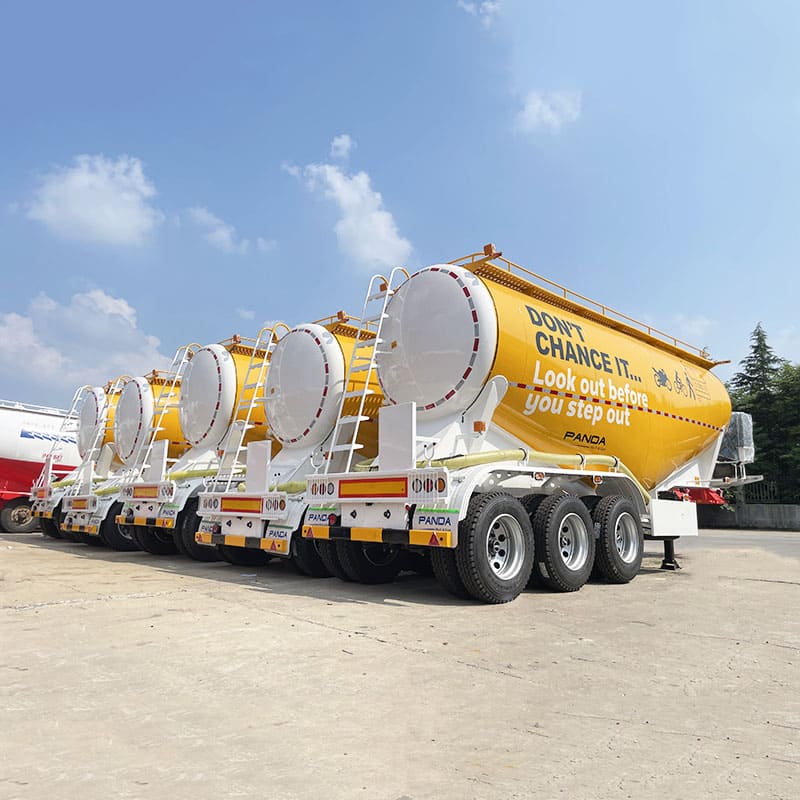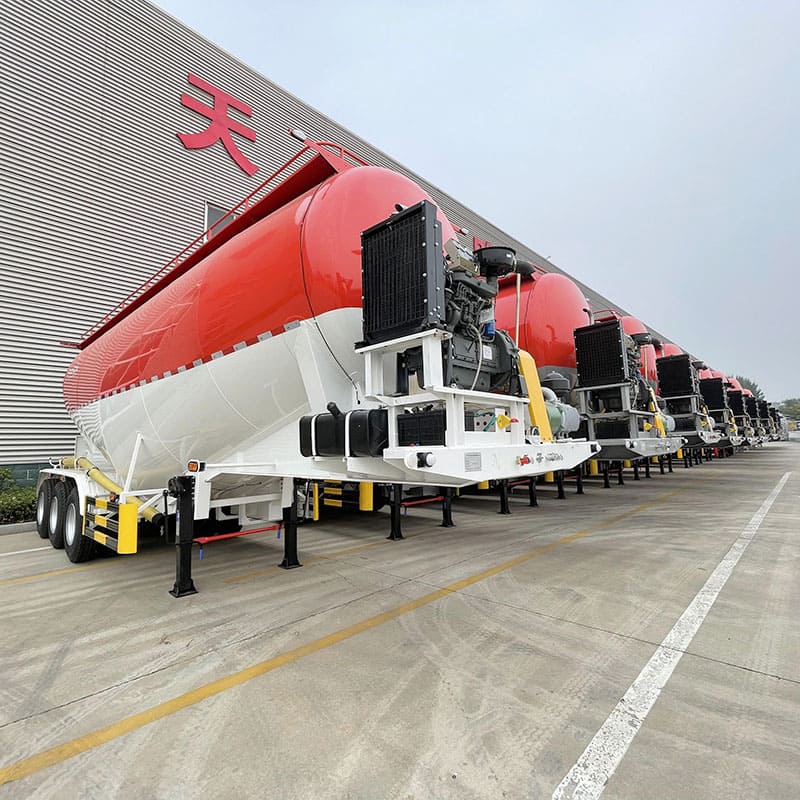The pneumatic dry bulk trailer is a special vehicle for moving cement. It’s made up of walking system, air pipeline system, brake system, and loading system. It’s designed for the safe delivery of bulk cement, lime powder, coal powder, and any dry powder with particles smaller than 0.1mm. You’ll typically see this trailer at cement factories, construction sites, and cement warehouses. Its use helps cut down on packing and unloading costs.
Its loading and unloading speeds far exceed those of normal bagged cement transportation.

Why Choose a Cement Tank Trailer for Dry Bulk Cement Transport?
Easy and Practical
A cement tank trailer can carry a lot of cement at once while keeping the cement safe from any moisture damage during the journey. There’s no need for much packing or unpacking, making the loading and unloading processes streamlined through fluidization.
Efficient and Dependable Delivery Speed
Cement tank trailers can transport large amounts of cement quickly and reliably. This method is cost-effective because it can handle huge volumes of cement in one go. All features aim to ensure efficient transportation and delivery of substantial cement quantities in the shortest time possible.
Large Carrying Capacity
With a capacity of up to 100 cubic meters 120 ton per set, a cement tanker trailer is ideal for transporting high volumes of cement.

Fluidization Principle in Cement Trailer
Compressed air from an air compressor enters the cement tanker, passing through a fluidized bed that turns the cement powder into a fluid-like state.
Typically, there are three upper entrances at the top of the dry bulk trailer. For the air pipe system, one air entrance pipe is positioned at the front and another at the back, each controlled separately by a ball valve.
When power is activated, it energizes the air compressor. The resulting compressed air flows into the tank, causing the cement powder to fluidize. When the pressure hits 0.2 Mpa, the butterfly valve can be opened for discharging. During operation of the dry bulk cement tanker trailer, bear in mind:

- The compressor’s working pressure shouldn’t exceed 0.2MPa. For safety, the pipeline is equipped with a safety valve, which will automatically vent the air when the pressure exceeds 0.2Mpa..
- Avoid altering the rotation direction of the air compressor.
- Perform maintenance every 30 hours of operation to clean the air filter, which should be replaced after every fifth maintenance.
The Pneumatic dry bulk trailer is excellent in transporting and unloading bulk cement, which can be limited to avoid moisture or caking of cement.
The pneumatic trailer features a fully enclosed compartment to store bulk cement, an manhole cover in an upper section of the compartment, and a front fitted with a device to inject compressed air. Compressed air enters the inside of the tank and turns the cement powder into fluidized form, which then flows out through the discharge valve.
Once fluidized, the cement can flow downward due to gravity toward the exit for unloading.
How to load a pneumatic trailer
Start by opening the pressure relief valve to let out any remaining compressed air in the tank.
Open the fill manhole cover and set the filter in place.
Begin loading cement into the tank.
Once loaded, clean any cement off the sealing ring and securely close the manhole cover.
Shut the pressure relief valve, and inspect other valves like the discharge butterfly valve to prevent any cement leakage during transport.

How to Unload the Pneumatic Trailer
- Discharge Pipe: Connect the discharge pipe, using a sealing ring for connection. Open the front and rear air inlet valves. Close the pressure relief valve, external air source valve, secondary blowing valve, and discharging butterfly valve.
- Air Compressor: Start the engine and the air compressor gently. Gradually increase the fuel to allow the air compressor to reach its rated speed and inflate the cement tank.
- Blow Valve: When pressure reaches about 0.15MPa, open the secondary auxiliary blow valve to clear the discharge pipe. Ensure the pipe isn’t blocked, then close the secondary auxiliary blow valve.
- Start Discharging: When pressure rises to 0.2MPa, open the discharging butterfly valve to begin unloading.
- Cleaning: Once the pressure decreases to about 0.02MPa and stabilizes, it means most of the cement in the tank has been discharged. Now, it’s time to clean the storage area.
- Closing: Shut the front air intake valve, leaving the rear air intake valve working. Watch the pressure gauge. If pressure increases, there’s residual material at the back of the tank. Once pressure rises and then settles back at around 0.02MPa, it means the rear portion has been unloaded.
- If pressure doesn’t rise again, the rear section has been discharged. Confirm that there’s no material left at the rear, open the front intake valve, and close the rear valve to clean any remaining material at the front of the tank. Again, observe the pressure gauge.
- If the pressure rises, there’s still material in the front. When pressure increases and then settles at around 0.02MPa, the front has been cleaned. If pressure doesn’t rise, there’s no material left in the front.
- Completion: Once you confirm no material is left at the front or the rear of the tank, turn off the engine, stop the air compressor, open the pressure relief valve, close the discharging butterfly valve, disconnect the discharge connector, and return the discharge pipes to the vehicle. Unloading is now complete.
Conclusion
The advent of the dry bulk cement tanker has significantly enhanced the safe transportation of large volumes of powdered products like cement. These pneumatic trailers utilize fluidization to efficiently deliver cement and similar products to various destinations.
Unlike traditional methods, these trailers can transport a substantial amount of cement in a single trip, sufficient for large-scale projects. This efficiency makes it a cost-effective solution for global cement transportation.
The fluidization process is a crucial component of this system. Here, fine cement particles transform into a fluid-like state when in contact with compressed air from an installed compressor within the trailer. When the air pressure reaches specific velocities, it supports the cement particles, allowing them to move freely without any obstruction.
In this setting, the fluidized bed resembles a vigorously boiling liquid where cement particles undergo a turbulent motion that intensifies with increasing air velocity. In essence, this method provides a swift and effective solution for transporting and unloading cement.


